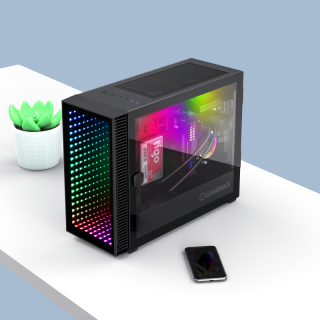With the rise of DIY computer building culture, PC cases have evolved from mere protective shells for hardware into central platforms for personalized display and performance optimization. As a dominant trend in recent years, the left-side ventilated design has become a standard feature for high-performance builds, valued for its unique combination of cooling efficiency and visual appeal. According to market research, the global PC case market reached $4.2 billion in 2023 and is projected to grow at a 5.8% compound annual growth rate through 2030, with left-side ventilated models accounting for over 40% of sales. This design not only caters to enthusiasts’ desire to showcase hardware but also significantly enhances cooling through its open structure, particularly critical for high-load scenarios involving top-tier graphics cards and processors.

Structural Innovation and Material Selection
Left-side ventilated cases typically feature large ventilation holes or mesh panels; some models include detachable metal grilles or magnetic dust filters, balancing airflow with dust protection. For example, certain cases use aluminum frames paired with tempered glass side panels, enhancing structural strength while enabling transparent display of internal RGB lighting. Modular designs allow users to freely swap panels, switching between fully ventilated and semi-transparent configurations to suit different cooling and aesthetic needs.
Optimized Airflow Channels
The left-side ventilation design increases intake area, working with front-mounted fans to create a "front-to-rear" three-dimensional airflow path. For instance, three 120mm fans at the front, combined with cool air intake from the left panel, directly cools the graphics card and motherboard VRM (voltage regulator module) areas, effectively reducing core temperatures. High-end models may also support bottom fan mounts, further enhancing airflow circulation at the case base and minimizing heat accumulation.
Hardware Compatibility and Expandability
These cases generally support multiple motherboard form factors (ATX, Micro-ATX, etc.) and offer ample space for large graphics cards and heatsinks. Some models accommodate flagship GPUs over 370mm in length and support 360mm liquid cooling radiators, meeting the cooling demands of high-end hardware. Modular hard drive bays and cable management spaces enhance internal layout flexibility, facilitating future upgrades to storage or cooling setups.
Enhanced Cooling Efficiency
The left-side ventilated design breaks from traditional enclosed structures, increasing air intake by 30–50% and significantly lowering internal temperatures. Test data shows that during dual stress tests, CPU temperatures can drop by 5–8°C, and GPU temperatures by 3–5°C, with more pronounced effects during overclocking or extended gaming sessions.
Customization Potential
Transparent side panels paired with RGB lighting transform hardware into a visual centerpiece. Users can create unique "light customization" setups by adjusting fan RGB effects, water-cooling tube layouts, or adding decorative elements. Some cases support synchronized lighting with motherboards and GPUs, enhancing overall aesthetic harmony.
Maintenance Convenience
Most left-side ventilated cases feature tool-free disassembly, allowing quick access for hardware upgrades or cleaning. Magnetic dust filters can be easily removed and washed, preventing performance degradation from dust accumulation. Modular structures enable flexible fan positioning or cooling scheme adjustments to adapt to changing hardware configurations.
Size and Compatibility
Motherboard Form Factor: Select a case that matches your motherboard size (ATX, Micro-ATX, etc.), ensuring screw hole alignment.
GPU Length: High-end graphics cards require at least 350mm of space; some flagship cases support GPUs over 400mm.
Cooler Height: For air coolers, check top clearance; for liquid cooling, confirm radiator mounting positions (front, top, or rear).
Cooling Design
Fan Slots: Opt for a base configuration with 3 front fans and 1 rear fan; prioritize models supporting liquid cooling radiators.
Dust Protection: Magnetic or detachable dust filters reduce debris buildup and extend hardware lifespan.
Airflow Optimization: Choose cases with front/left intake and rear/top exhaust for smooth airflow circulation.
Expandability and Usability
Storage Support: Select based on needs (2–4 x 3.5" HDDs and 4–6 x 2.5" SSDs).
Cable Management: Rear cable routing channels and Velcro straps improve internal tidiness and reduce airflow obstruction.
I/O Ports: Front-facing USB 3.2 Gen 2 Type-C and audio jacks are current mainstream requirements.
Regular Cleaning
Dust Removal: Use compressed air or a soft brush monthly to clean internal components, focusing on fans, heatsinks, and filters.
Filter Maintenance: Wash magnetic dust filters quarterly to prevent clogging and maintain cooling efficiency.
Temperature Monitoring
Software Tools: Use utilities like HWMonitor or Core Temp to track CPU and GPU temperatures (ideally below 85°C for CPUs and 80°C for GPUs).
Fan Control: Adjust fan speeds based on load to balance cooling and noise, such as lowering speeds during low-intensity tasks.
Hardware Upgrades
Cooling Upgrades: Add top/bottom fans or switch to a liquid cooling system if existing cooling is insufficient.
Compatibility Checks: Ensure case space and power supply wattage support new hardware when upgrading GPUs or motherboards.
The left-side ventilated design has become essential for high-performance PCs, excelling in balancing cooling efficiency and personalization. As hardware performance and aesthetic demands grow, future cases will emphasize modularity, refine airflow dynamics, and integrate smart thermal controls. For DIY enthusiasts, choosing a well-structured, compatible left-side ventilated case not only boosts system performance but also serves as a statement of personal style, making it a focal point of any desktop setup.

Ultimate Mini ITX PC The Abyss ITX has it all in a 0.7 cubic foot size and a mesmerizing infinity front mirror front panel
• Wersquo;ve combined style, upgradability and portability without sacrificing superior cooling, flexibility, or performance, speed, and power
• Dual Side Panel Doors
• The Abyss ITX is equipped to easily handle future upgrades
• Both side panels swing open like doors giving you quick access to swap components effortlessly
• A 4mm thick tempered glass (3-5 times stronger that common glass) door showcases your motherboard, RAM, and CPU
• On the other side, the vented door is perfectly positioned for your GPU to exhaust heat out of your case
• Easy Connectivity
• Maximum Airflow
• High Performance in a Mini Size One man One machine!